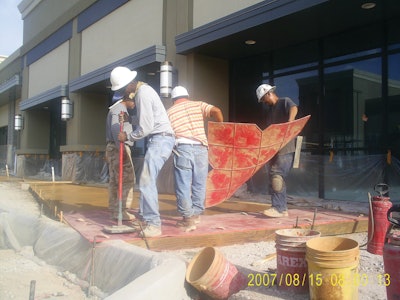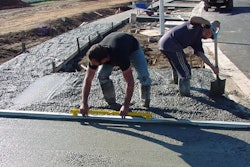
Vertical Artisans
Hickory Hills, Ill.
Tools: Textured rollers, mats and skims; series of molds, trowels,
Beginning his career in decorative concrete in 1999, Nathan Griffin saw opportunity in an area that was virtually nonexistent – vertical decorative concrete. "You would see it in zoos, casinos and expensive hotels, but it hadn't worked its way down into the residential marketplace," Griffin says. "I saw an opportunity that allowed for a vast market to open up simply by scaling down the projects."
As a result, Griffin brought vertical concrete to clients looking for wine cellars, fireplaces, koi ponds and pillars. Several years later, Griffin began Vertical Artisans, an online school that teaches contractors the craft of vertical decorative concrete. When completing vertical concrete projects, Griffin uses a variety of tools.
"Asking about my favorite tool is a loaded question," Griffin says. "We use many tools, and to pick a favorite would be to say one tool does the entire thing. It is all a step by step process."
Griffin believes textured rollers, textured trowels, the wedge and textured mats are some of the most important tools in his toolbox.
He also enjoys creating new tools. Recently, he released a series of molds that create an exposed stone style. "Our perspective is there are four times as many walls as floors," Griffin says. "So, there are about four times as many applications that can be used, created and invented. We try to create new markets for the vertical industry."
Progressive Hardscapes
Phoenix, Ariz.
Toolbox: Bunyan Striker, Bomanite stamps, textured tools, skil saw, v-cut grinders and diamond blades
Mike Riggs began his career in the concrete industry in 1979 working for his father's company. Initially, the company focused on standard concrete work for residential clients, but in the 1970s his father started working with Bomanite Systems, a cast-in-place, colored, textured and imprinted concrete paving. By working with the Bomanite System, the company slowly developed a niche in decorative concrete work. Mike was recently hired by Colorado Hardscapes to open a new decorative concrete division Progressive Hardscapes operating in Phoenix, AZ.
With a crew of 15, Progressive Hardscapes offers decorative services including stamped, polished, stained and concrete overlays. The company also completes pervious concrete installation using Drainscape. The majority of clients are commercial including several government projects such as municipalities.
One of Riggs favorite tools, as well as his crew, are Bomanite stamps. Progressive Hardscapes uses about 25 different patterned Bomanite stamps ranging from standard Asher Slate to standard Slate. "We use Bomanite stamps because they are the highest quality imprinted tools we have worked with," Riggs says.
Another important tool in the Progressive Hardscapes arsenal is a variety of templates used for sandblasting. "We like template sandblasting because so many custom looks can be created, and the finished product not only looks great but is very durable," Riggs says.
The crews use standard skil saws with dry blades to cut the joints of decorative concrete projects. Along with the skil saws, they also use diamond blades and grinders to complete various tasks on the projects. Lithocrete, a process that uses exotic aggregates and seeded glass, is often used by the Progressive Hardscapes crew.



















